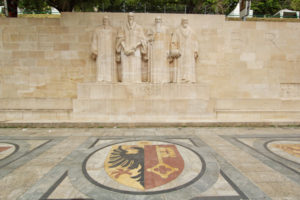Luther’s Scruples Exhaust Staupitz
Patient and Persistent Mentor
Tucked away in the pages of Reformation history lies the figure of Johann von Staupitz. His is certainly not the first name that comes to mind when considering the Reformation heroes. He served as Martin Luther’s superior within the Augustinian Order and importantly also as his father confessor during the first decade of the 1500s. It is hard to imagine the Reformation without him.
Little is know about Stauptiz’s origins. However, his extensive and varied education is documented. He studied Liberal Arts and the theological system of Thomas Aquinas, receiving his Master of Arts in 1489. Staupitz furthered his studies at the University of Tübingen, where he earned a doctorate in theology by 1500.
Having been exposed to the various, and often, contradictory, schools of theological thought, Staupitz found himself returning to the teachings of St. Augustine. This was a study rooted in Scripture and an evangelical concern for pastoral care.
Over the next few years, Staupitz would rise to positions of leadership and was ultimately named Vicar-General of the Reformed branch of the Augustinian Order. It was in this context that Luther became acquainted with Staupitz. As Luther’s superior and father confessor, he saw Luther through some of the darkest moments of his spiritual trials.
Staupitz never gave up
Staupitz had no idea what he was getting into when he first met Martin Luther in 1506. Luther had recently left his legal studies at the University of Erfurt to embrace a life of monastic rigor in the Augustinian monastery. He brought with him a deepening spiritual crisis that would pose a challenge for Staupitz in his role as mentor and personal confessor. His new charge would tax his considerable abilities to the limit.
Martin Luther was, at this time, plagued by his own sinfulness. He felt compelled to share his every sin when it came to the confessional. It is perhaps no exaggeration to say that Staupitz saved Luther’s life. In his despair and severe lifestyle of fasting to unhealthy degrees, and other forms of physical inflictions, it is doubtful that Luther could have survived his self-inflicted torment.
Staupitz faithfully took great care of Luther and pointed him again and again to the grace and love of Christ. As well as the atonement that is the cross. He challenged Luther to just let go of his guilt and love God. Yet, Luther, in his dread of God and in desperation, could not simply love Him. “Love God!” the Luther responded, “I hate God!”
Martin Luther, later reflecting on Johann wrote “If it had not been for Dr. Staupitz, I should have sunk in hell.”
Engagement with Scripture
Staupitz suggested Luther be sent as an emissary to Rome. This fateful trip, intended to ease Luther’s spiritual crisis, only intensified it as his eyes were opened for the first time to many of the ugly realities of sixteenth century Catholicism. Staupitz, serving as the first dean of the new University of Wittenberg, invited his young student to study and teach there in 1508. This opportunity opened the door to Luther’s engagement with scripture.
Luther’s engagement with scripture and theology brought him to understand that salvation was based on the merits of Christ, rather than the personal merit of sinful humans.
Those insights would soon shake the world.
Reformation Tours
Join us as we journey through the breath-taking landscape of Germany and Switzerland to uncover the fascinating history of Martin Luther and the reformation movement. Our Christian reformation tours are composed of significant sites and locations coupled with expert teaching along the way. These tours are often led by notable teachers such as award-winning author, Dr. Erwin Lutzer of the Moody Church. Immerse yourself in the rich history of Martin Luther and the reformers as you visit the sites where Luther carried out his daily worship and conducted his teachings. Walking the same path’s as Luther once did will heighten your understanding of the reformation movement, as well as, the struggles he faced during the process. Travel in awe as you stop by the historical sites of Castle Church, Charlottenburg Place, Luther House, Zeppelinfeld, Bern – the political capital of Switzerland, Augustinian Monastery, Reformer Wall, Lake Geneva, and many more.



